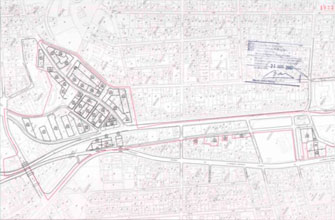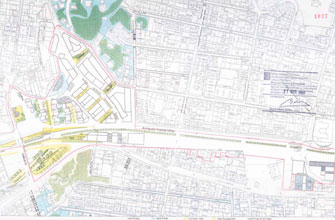PLUS ULTRA
VALLCARCA
TRINITAT NOVA
X
Urban transformation
Research
VALLCARCA
The neighbourhood of Vallcarca began to be created during the first half of the twentieth century, in Horta, on the outskirts of the town of Gràcia. There was a first settlement of family houses for summer quickly formed a small town with orchards and gardens, built without following any urban plan.
In the later decades of the twentieth century, the population density of the area was increasing rapidly, and with it the economic and commercial activity, which gave rise to the emergence of small industrial and craft workshops, night clubs, and a cinema.
Later, the neighborhood has been affected by the project of the Penitents tunnel, an extension of the urban motorway called “Via 0”, after crossing Gràcia. The “General Metropolitan Plan” of 1976 included this route and the disappearance of all the buildings in the affected area. Therefore, some of the housing buildings in the neighborhood have been progressively deteriorating as the plan prevented their refurbishment.
Some years later, the “Modification to the General Metropolitan Plan” of 2002 brought the abandonment of the “Via 0” project for being considered incompatible with the new Special Plan of Interior Reform of Gràcia. This opened the door to a new kind of urban development for the area. Thus, the plan modification proposed a green boulevard with two-way traffic in the Avinguda Hospital Militar Avenue, which would become the central public space of the area. However, this new route entailed the demolition of southern side of the Bolivar Street, up to the modernist house Comas d'Argemir (designed by architect Josep Vilaseca i Casanovas, located in the Republic Argentina Avenue), with the subsequent relocation of the affected residents who would be moved near the Vallcarca bridge. In addition, a new access path was foreseen that would cross the oldest and damaged core of neighborhood to connect Vallcarca Avenue with Plaza de Mons.
The fact that various areas of Vallcarca have been subjected to right of way during a long time has contributed to the progressive depopulation, to the deterioration and abandonment of the built heritage and to the gradual destruction of the social and commercial fabric. In parallel, private developers have tried to take advantage of the low value of the land compared to the high value of the new homes could be built.
In these circumstances, the urban improvement plan “Pla de Millora Urbana per a l'ajust viari I l'ordenació entre el viaducte de Vallcarca, l'Avinguda de Vallcarca i el carrer de Gustavo Adolfo Bécquer” from 2008 represents the final stage of the urban regulatory process. The plan proposes to modify the system of paths and public spaces to create green corridors between Putxet and Park Güell. This idea has been later reinforced with the plan “Les Portes de Collserola” proposed by the City Council in the year of 2012 with the goal of easing the connections between the Collserola park and the city. According to this plan, the avenue Vallcarca- Penitents would be “Gate 7: Penitents”.
Currently, the urban transformation process is called off as a result of the financial and real-estate crisis. Large parts of the district have been demolished while other are still in ruins. This situation has led to the mobilization of residents, especially of those living in areas close to Farigola Street and to the viaduct of Vallcarca, where various self-managed public spaces and urban gardens have emerged. The various neighbors’ associations remain active, and they insist to be taken into account in the decision making processes about the future of the areas that still have to be urbanized.
Since the entry into force of the General Metropolitan Plan (In Spanish: Plan General Metropolitano- PGM) of 1976, Vallcarca has been affected by the subsequent Modification of the General Metropolitan Plan (In Spanish: Modificación del Plan General Metropolitano- MPGM) of 2002 and later by the Urban Improvement Plan (In Spanish: Plan de Mejora Urbano- PMU) approved in 2008. Recently, buildings on the Farigola Street and some in Vallcarca Avenue, have been demolished. Some neighbours have been relocated in a building built in front of the exit of Vallcarca Metro station. Since the approval of the first plan, the neighbourhood has been steadily deteriorating and most of the houses are in a precarious situation. This progressive deterioration of the housing has led, in some cases, to the change of residence of the original residents. Some of their houses have been illegally occupied. To this circumstance, we should add the recent transformation of the beginning of Avenue Vallcarca which has resulted in vacant urban spaces as a result of the demolition of some buildings.
In this context, the research project Prohabit aims to answer the following question: How do they neighbours live, perceive and value the changes that are happening in the neighbourhood? For this purpose the following research topics will be addressed:
• How do neighbours perceive the transformation of the neighbourhood? How does their perception affect the image or identity of the place?
• What influence do changes have in people, especially in those relocated? How do these changes affect their daily life?
• What is the value of the new spaces for the residents (former residents, newcomers, squatters, migrants) that have emerged in the neighbourhood?? How they are using them?
• What are the expectations about the outcome of urban transformation? What are the needs of the residents in relation to public spaces in the neighbourhood? What uses are proposed for the empty spaces that were created after the demolition?



